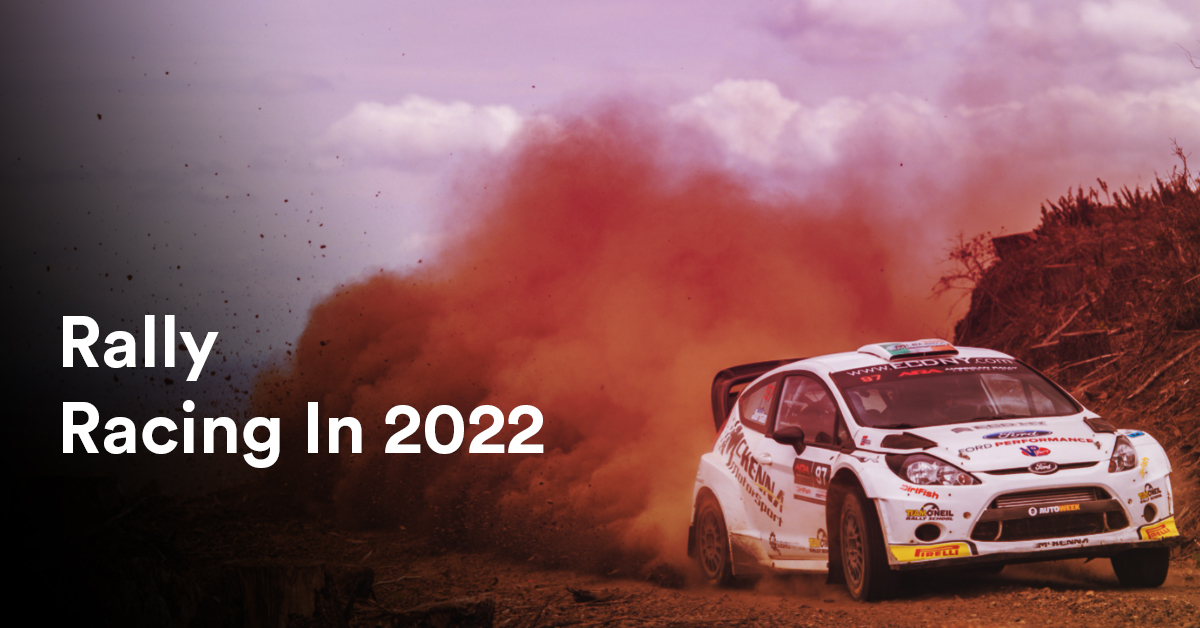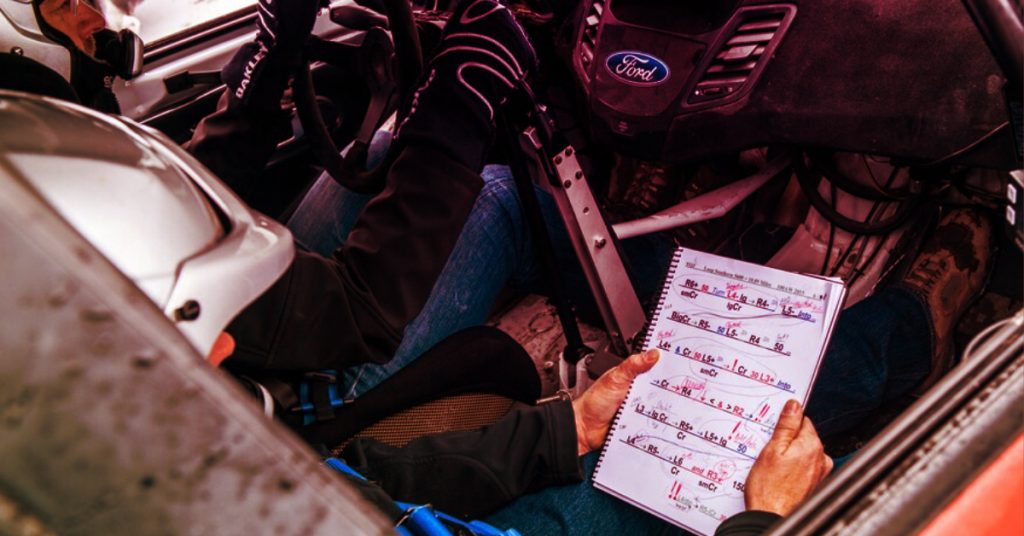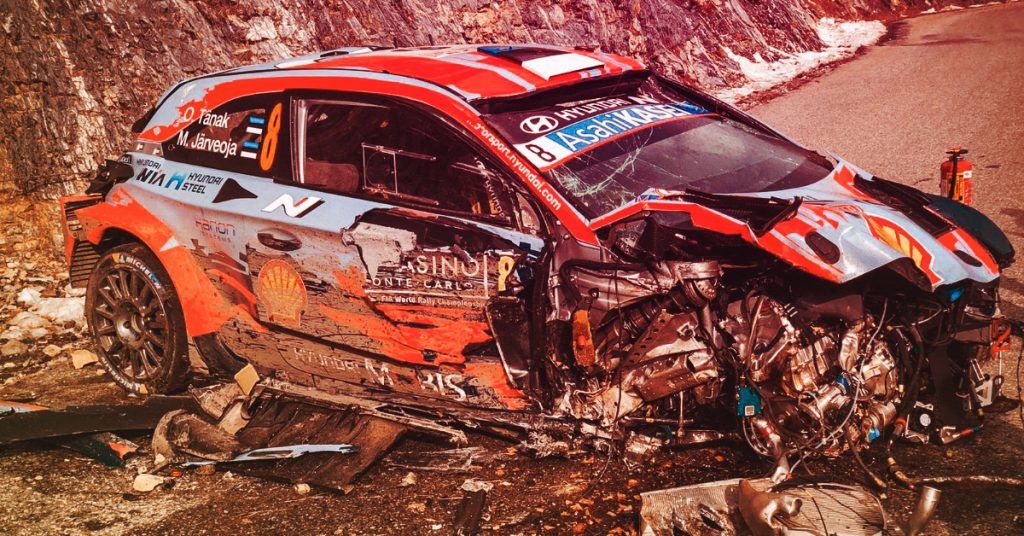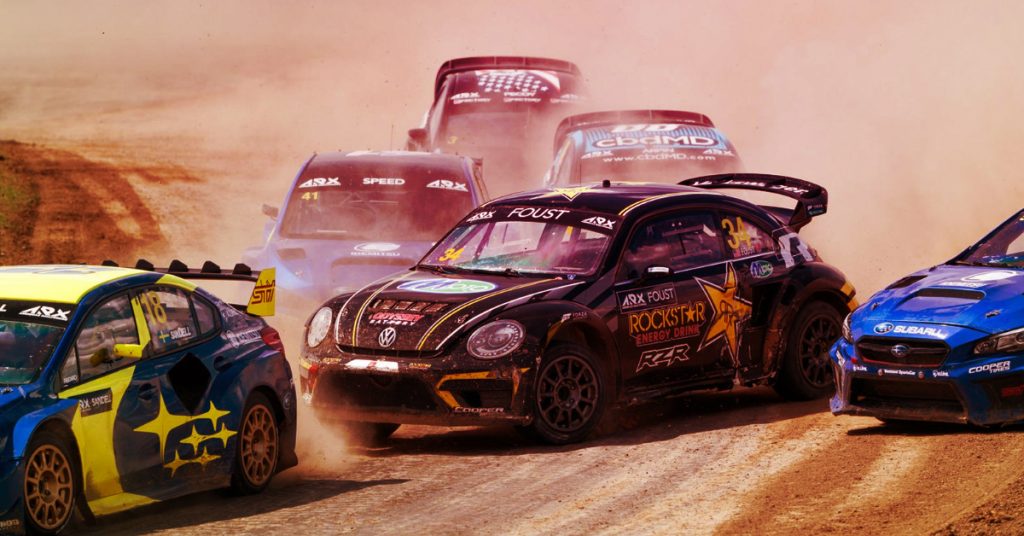
How To Get Properly Into Rally Racing in 2022
[/vc_column_text]
Co-Driver

The co-driver is the person in the car who navigates for the driver. Drivers are required to have someone in the car with them during racing because there may be times when they can’t see the road and need to be told where to go. The co-driver does this by reading a set of notes called pace notes aloud that describe the upcoming stages and obstacles such as turns, jumps, hazards (trees, rocks), etc.
Pacenotes are what drivers and co-drivers speak throughout the race about the terrain of the road, and they describe everything about the road all at once.
For example, there is a curve that goes to the right after a bridge. The co-driver will say “right tightens then bridge” or “right tightens turn”. The shortest pace notes are two words long and usually consist of a noun describing an obstacle or turn, and then a direction. Most sections of the track are broken into four parts – A, B, C, D. The co-driver will read out what section they’re in (“A”) and then describe where it goes (the noun) and how long it is (usually with time markers).
The Money

Drivers can make an average of $35,000 to $50,000 per season, but they will spend more than that on their cars and modifications. Most drivers are sponsored by companies that supply them with funding for racing as well as spare parts.
When you factor in the cost of your car(s) and all the extra expenses, you need to make sure you can pay for it all before making a commitment to rally racing. Cars and parts are very expensive and the costs never end, as your car will always need spare parts and repairs. Drivers spend an average of $4,000 per race weekend (travel costs included), but that number varies depending on the event they’re participating in and how well they finish.
[/vc_column_text]
The Car

Rally Racing is expensive enough as it is without having to build a rally car from scratch. Most people that start out in this sport will use a car that is already modified for street use to lower the costs, although it’s much more advisable to build a car from scratch.
The first thing you need to find is the group of cars allowed to compete in your desired class and division. The FIA (Federation Internationale De L’Automobile) has divisions classifying cars based on their specifications, as well as different regulations for each. Different regulations include the power output of the car (usually measured in horsepower), weight, and suspension modifications. There are classes that allow forced induction (turbo or supercharging), but most drivers will avoid them because they are considered “unlimited”. This means the engineers have free reign to modify their cars as they want.
There are several different rally racing organizations across North America, but most competitors will boast an FIA license to be able to compete at a professional level. Below is a list of some of the groups you can race with:
Competitors who want to race need an FIA Racing License, usually divided into several different categories. R-GT designates cars in the rally high group and top-level motorsport, requiring the most stringent of qualifications to achieve and allowing for more sophisticated and powerful cars than other groups.
- Group N is designated for gravel rallies that allow any production-based car with almost no modifications except for safety reasons.
- Group A is for tarmac rallies and requires several modifications to the car’s suspension, aerodynamics, power output, and weight rating. It also requires more powerful cars than Group N.
- Group 2 is the group with the lowest requirements for modifications to your car, but still has higher standards than Group N or R-GT.
- Group B is a class that has been discontinued because of the high speeds and overly dangerous modifications required to compete in it. The cars were very high-powered with different requirements for each manufacturer. Group B allowed turbocharger cars, no restriction on engine capacity, and minimal weight restrictions. And since drivers could modify their car as they saw fit, it allowed for some very powerful cars.
You may have to try out more than one group before you find the one that fits your car and your budget, but most people will start off in a class where they can be competitive with a reasonable amount of money without having to do too many modifications. The lower cost of entry usually leads to lower expenses, although it may be more difficult to win races. It’s also easier to upgrade into a higher class later if you want or need to.
Co-Driver

The co-driver is the person in the car who navigates for the driver. Drivers are required to have someone in the car with them during racing because there may be times when they can’t see the road and need to be told where to go. The co-driver does this by reading a set of notes called pace notes aloud that describe the upcoming stages and obstacles such as turns, jumps, hazards (trees, rocks), etc.
Pacenotes are what drivers and co-drivers speak throughout the race about the terrain of the road, and they describe everything about the road all at once.
For example, there is a curve that goes to the right after a bridge. The co-driver will say “right tightens then bridge” or “right tightens turn”. The shortest pace notes are two words long and usually consist of a noun describing an obstacle or turn, and then a direction. Most sections of the track are broken into four parts – A, B, C, D. The co-driver will read out what section they’re in (“A”) and then describe where it goes (the noun) and how long it is (usually with time markers).
The Money

Drivers can make an average of $35,000 to $50,000 per season, but they will spend more than that on their cars and modifications. Most drivers are sponsored by companies that supply them with funding for racing as well as spare parts.
When you factor in the cost of your car(s) and all the extra expenses, you need to make sure you can pay for it all before making a commitment to rally racing. Cars and parts are very expensive and the costs never end, as your car will always need spare parts and repairs. Drivers spend an average of $4,000 per race weekend (travel costs included), but that number varies depending on the event they’re participating in and how well they finish.
[/vc_column_text]
What You Need To Do Rallying
To compete in a rally, there are basically three things you need to have: the car, the co-driver, and the money. Let’s go over them one at a time starting with…
The Car

Rally Racing is expensive enough as it is without having to build a rally car from scratch. Most people that start out in this sport will use a car that is already modified for street use to lower the costs, although it’s much more advisable to build a car from scratch.
The first thing you need to find is the group of cars allowed to compete in your desired class and division. The FIA (Federation Internationale De L’Automobile) has divisions classifying cars based on their specifications, as well as different regulations for each. Different regulations include the power output of the car (usually measured in horsepower), weight, and suspension modifications. There are classes that allow forced induction (turbo or supercharging), but most drivers will avoid them because they are considered “unlimited”. This means the engineers have free reign to modify their cars as they want.
There are several different rally racing organizations across North America, but most competitors will boast an FIA license to be able to compete at a professional level. Below is a list of some of the groups you can race with:
Competitors who want to race need an FIA Racing License, usually divided into several different categories. R-GT designates cars in the rally high group and top-level motorsport, requiring the most stringent of qualifications to achieve and allowing for more sophisticated and powerful cars than other groups.
- Group N is designated for gravel rallies that allow any production-based car with almost no modifications except for safety reasons.
- Group A is for tarmac rallies and requires several modifications to the car’s suspension, aerodynamics, power output, and weight rating. It also requires more powerful cars than Group N.
- Group 2 is the group with the lowest requirements for modifications to your car, but still has higher standards than Group N or R-GT.
- Group B is a class that has been discontinued because of the high speeds and overly dangerous modifications required to compete in it. The cars were very high-powered with different requirements for each manufacturer. Group B allowed turbocharger cars, no restriction on engine capacity, and minimal weight restrictions. And since drivers could modify their car as they saw fit, it allowed for some very powerful cars.
You may have to try out more than one group before you find the one that fits your car and your budget, but most people will start off in a class where they can be competitive with a reasonable amount of money without having to do too many modifications. The lower cost of entry usually leads to lower expenses, although it may be more difficult to win races. It’s also easier to upgrade into a higher class later if you want or need to.
Co-Driver

The co-driver is the person in the car who navigates for the driver. Drivers are required to have someone in the car with them during racing because there may be times when they can’t see the road and need to be told where to go. The co-driver does this by reading a set of notes called pace notes aloud that describe the upcoming stages and obstacles such as turns, jumps, hazards (trees, rocks), etc.
Pacenotes are what drivers and co-drivers speak throughout the race about the terrain of the road, and they describe everything about the road all at once.
For example, there is a curve that goes to the right after a bridge. The co-driver will say “right tightens then bridge” or “right tightens turn”. The shortest pace notes are two words long and usually consist of a noun describing an obstacle or turn, and then a direction. Most sections of the track are broken into four parts – A, B, C, D. The co-driver will read out what section they’re in (“A”) and then describe where it goes (the noun) and how long it is (usually with time markers).
The Money

Drivers can make an average of $35,000 to $50,000 per season, but they will spend more than that on their cars and modifications. Most drivers are sponsored by companies that supply them with funding for racing as well as spare parts.
When you factor in the cost of your car(s) and all the extra expenses, you need to make sure you can pay for it all before making a commitment to rally racing. Cars and parts are very expensive and the costs never end, as your car will always need spare parts and repairs. Drivers spend an average of $4,000 per race weekend (travel costs included), but that number varies depending on the event they’re participating in and how well they finish.
Rally is usually driven on unpaved roads in nature in any weather condition. Drivers have to deal with things like muddy roads, rain, snow, and ice. Once a rally has started the drivers cannot touch the car to fix it in any way for that entire stage or their time will be disqualified. Rally races can also be very long because of all the stages, some lasting over a day.
[/vc_column_text]
What You Need To Do Rallying
To compete in a rally, there are basically three things you need to have: the car, the co-driver, and the money. Let’s go over them one at a time starting with…
The Car

Rally Racing is expensive enough as it is without having to build a rally car from scratch. Most people that start out in this sport will use a car that is already modified for street use to lower the costs, although it’s much more advisable to build a car from scratch.
The first thing you need to find is the group of cars allowed to compete in your desired class and division. The FIA (Federation Internationale De L’Automobile) has divisions classifying cars based on their specifications, as well as different regulations for each. Different regulations include the power output of the car (usually measured in horsepower), weight, and suspension modifications. There are classes that allow forced induction (turbo or supercharging), but most drivers will avoid them because they are considered “unlimited”. This means the engineers have free reign to modify their cars as they want.
There are several different rally racing organizations across North America, but most competitors will boast an FIA license to be able to compete at a professional level. Below is a list of some of the groups you can race with:
Competitors who want to race need an FIA Racing License, usually divided into several different categories. R-GT designates cars in the rally high group and top-level motorsport, requiring the most stringent of qualifications to achieve and allowing for more sophisticated and powerful cars than other groups.
- Group N is designated for gravel rallies that allow any production-based car with almost no modifications except for safety reasons.
- Group A is for tarmac rallies and requires several modifications to the car’s suspension, aerodynamics, power output, and weight rating. It also requires more powerful cars than Group N.
- Group 2 is the group with the lowest requirements for modifications to your car, but still has higher standards than Group N or R-GT.
- Group B is a class that has been discontinued because of the high speeds and overly dangerous modifications required to compete in it. The cars were very high-powered with different requirements for each manufacturer. Group B allowed turbocharger cars, no restriction on engine capacity, and minimal weight restrictions. And since drivers could modify their car as they saw fit, it allowed for some very powerful cars.
You may have to try out more than one group before you find the one that fits your car and your budget, but most people will start off in a class where they can be competitive with a reasonable amount of money without having to do too many modifications. The lower cost of entry usually leads to lower expenses, although it may be more difficult to win races. It’s also easier to upgrade into a higher class later if you want or need to.
Co-Driver

The co-driver is the person in the car who navigates for the driver. Drivers are required to have someone in the car with them during racing because there may be times when they can’t see the road and need to be told where to go. The co-driver does this by reading a set of notes called pace notes aloud that describe the upcoming stages and obstacles such as turns, jumps, hazards (trees, rocks), etc.
Pacenotes are what drivers and co-drivers speak throughout the race about the terrain of the road, and they describe everything about the road all at once.
For example, there is a curve that goes to the right after a bridge. The co-driver will say “right tightens then bridge” or “right tightens turn”. The shortest pace notes are two words long and usually consist of a noun describing an obstacle or turn, and then a direction. Most sections of the track are broken into four parts – A, B, C, D. The co-driver will read out what section they’re in (“A”) and then describe where it goes (the noun) and how long it is (usually with time markers).
The Money

Drivers can make an average of $35,000 to $50,000 per season, but they will spend more than that on their cars and modifications. Most drivers are sponsored by companies that supply them with funding for racing as well as spare parts.
When you factor in the cost of your car(s) and all the extra expenses, you need to make sure you can pay for it all before making a commitment to rally racing. Cars and parts are very expensive and the costs never end, as your car will always need spare parts and repairs. Drivers spend an average of $4,000 per race weekend (travel costs included), but that number varies depending on the event they’re participating in and how well they finish.
So you want to go into Rally Racing? That’s great because rally racing is awesome and can be pretty horrifically dangerous. And fun. Danger and fun.
Most likely you saw a couple of races on tv or online, played a few rally games, and now you want to try out the real deal. Before starting anything, keep in mind that this is a dangerous and expensive sport that can provide some of the best experiences in your life, as well as potential horrific injuries or even death.
Table of Contents
What Is Rally Racing?
Rally racing, also known as stage rallies, are races where drivers race against the clock rather than each other. The course is made of multiple sections called “stages” that are closed to the public and open only to official competitors. Each driver must perform their best on each stage without making any major mistakes or defects for their time between two points, called “controls”, to be counted. During the race, drivers usually cannot feel their speed as they might in a normal racing circuit or on public roads because of this lack of feeling, rallies tend to be much faster and more dangerous than other forms of motorsport.
Rally is usually driven on unpaved roads in nature in any weather condition. Drivers have to deal with things like muddy roads, rain, snow, and ice. Once a rally has started the drivers cannot touch the car to fix it in any way for that entire stage or their time will be disqualified. Rally races can also be very long because of all the stages, some lasting over a day.
What You Need To Do Rallying
To compete in a rally, there are basically three things you need to have: the car, the co-driver, and the money. Let’s go over them one at a time starting with…
The Car

Rally Racing is expensive enough as it is without having to build a rally car from scratch. Most people that start out in this sport will use a car that is already modified for street use to lower the costs, although it’s much more advisable to build a car from scratch.
The first thing you need to find is the group of cars allowed to compete in your desired class and division. The FIA (Federation Internationale De L’Automobile) has divisions classifying cars based on their specifications, as well as different regulations for each. Different regulations include the power output of the car (usually measured in horsepower), weight, and suspension modifications. There are classes that allow forced induction (turbo or supercharging), but most drivers will avoid them because they are considered “unlimited”. This means the engineers have free reign to modify their cars as they want.
There are several different rally racing organizations across North America, but most competitors will boast an FIA license to be able to compete at a professional level. Below is a list of some of the groups you can race with:
Competitors who want to race need an FIA Racing License, usually divided into several different categories. R-GT designates cars in the rally high group and top-level motorsport, requiring the most stringent of qualifications to achieve and allowing for more sophisticated and powerful cars than other groups.
- Group N is designated for gravel rallies that allow any production-based car with almost no modifications except for safety reasons.
- Group A is for tarmac rallies and requires several modifications to the car’s suspension, aerodynamics, power output, and weight rating. It also requires more powerful cars than Group N.
- Group 2 is the group with the lowest requirements for modifications to your car, but still has higher standards than Group N or R-GT.
- Group B is a class that has been discontinued because of the high speeds and overly dangerous modifications required to compete in it. The cars were very high-powered with different requirements for each manufacturer. Group B allowed turbocharger cars, no restriction on engine capacity, and minimal weight restrictions. And since drivers could modify their car as they saw fit, it allowed for some very powerful cars.
You may have to try out more than one group before you find the one that fits your car and your budget, but most people will start off in a class where they can be competitive with a reasonable amount of money without having to do too many modifications. The lower cost of entry usually leads to lower expenses, although it may be more difficult to win races. It’s also easier to upgrade into a higher class later if you want or need to.
Co-Driver

The co-driver is the person in the car who navigates for the driver. Drivers are required to have someone in the car with them during racing because there may be times when they can’t see the road and need to be told where to go. The co-driver does this by reading a set of notes called pace notes aloud that describe the upcoming stages and obstacles such as turns, jumps, hazards (trees, rocks), etc.
Pacenotes are what drivers and co-drivers speak throughout the race about the terrain of the road, and they describe everything about the road all at once.
For example, there is a curve that goes to the right after a bridge. The co-driver will say “right tightens then bridge” or “right tightens turn”. The shortest pace notes are two words long and usually consist of a noun describing an obstacle or turn, and then a direction. Most sections of the track are broken into four parts – A, B, C, D. The co-driver will read out what section they’re in (“A”) and then describe where it goes (the noun) and how long it is (usually with time markers).
The Money

Drivers can make an average of $35,000 to $50,000 per season, but they will spend more than that on their cars and modifications. Most drivers are sponsored by companies that supply them with funding for racing as well as spare parts.
When you factor in the cost of your car(s) and all the extra expenses, you need to make sure you can pay for it all before making a commitment to rally racing. Cars and parts are very expensive and the costs never end, as your car will always need spare parts and repairs. Drivers spend an average of $4,000 per race weekend (travel costs included), but that number varies depending on the event they’re participating in and how well they finish.

